Sales Playbooks: The X’s and O’s of Company-Directed Sales Organizations
Growing companies often hit a barrier when their established ways of meeting customer needs are no longer sufficient to support their aspirations. The entrepreneurial, get-it-done mindset that enabled them to capture new customers and grow share through rapid decision-making, flexibility, and responsiveness to market needs can become an impediment. More customers lead to more varied demands. A larger sales team leads to a larger variety of ad-hoc sales processes applied toward finding new customers and serving existing ones. Additional market segments often require additional go-to-market approaches to address the variety in buyer values and buyer behaviors.
In addition to these internal challenges, the external environment can also change, requiring a thoughtful approach to the deployment of commercial resources. Once-promising markets may become stagnant. Customers become more sophisticated, increasing their knowledge about the products and services they buy, adopting more complex and structured buying processes, stratifying their suppliers by the level of value they provide – and compensating them accordingly. These external market challenges require a strategic and planned sales approach, not the opportunistic hunting that characterized the earlier growth phase.
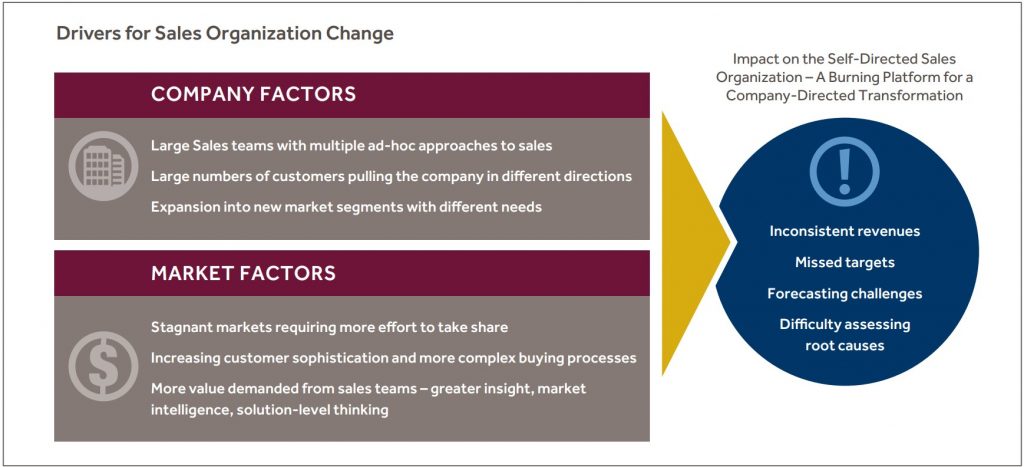
The net result of this ad hoc and opportunistic sales organizations – what we like to call “self-directed” sales organizations – is inconsistency in revenue results, difficulty in forecasting, and missed targets. Attempts to diagnose the source of the inconsistency often prove futile. A number of confounding variables make it difficult to pinpoint the primary drivers. Is the uneven sales performance an outcome of different skills?
Different tenures? Different sales approach? Different clients with different demands and buying cycles? In our work with more than 300 companies, we often hear these questions from heads of sales and C-level executives looking to ratchet up their sales team performance. Whether they are driven to investigate their sales process due to higher growth aspirations, uneven performance, missed targets, planned entry into new market segments, an M&A event, or any other reason, the best starting point is always the same: transform the self-directed sales organizations into a company-directed sales organization.
Company-Directed Sales Organizations
In a company-directed sales model, reps are consistent in their use of a defined sales process. They follow the same proven steps and therefore can predict with greater accuracy which prospects are most likely to close and when. They have segmented their clients and prospects and have created targeted go-to-market approaches for each segment that are more likely to resonate with each client and prospect. Without differing sales processes as a confounding variable, managers can isolate the impact of “skill and will” shortcomings in their teams and take corrective action quickly.
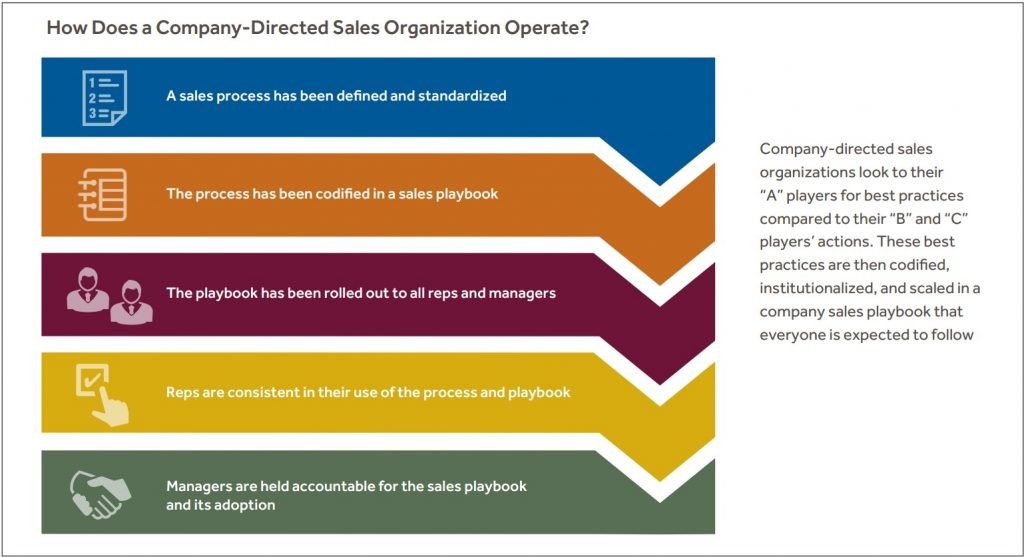
So how do you get there? It starts with your high-performing sales reps. Many managers believe these “A” players possess some intrinsic ability that is key to their success, and that they have some “secret sauce” that cannot be replicated. But just as a real secret sauce originates with experimentation and corrections until, upon perfection, it can be replicated and scaled, top performers’ recipes for success can be codified and copied. In a company-directed sales model, this knowledge transfer is institutionalized; in self- directed models it is ad hoc.
One mid-level financial services sales executive demonstrated this principle. From an early age, he was gregarious, intelligent, and a leader who inspired followership. He took leadership positions in all of his extracurricular activities and won many awards for his leadership. When he joined the workforce, he became a star performer early in his career as a commercial insurance broker, which wasn’t a surprise to anyone. Clearly, he was destined for greatness.
Except that conclusion would be missing the point. While his interpersonal traits certainly played a role when he got in front of prospects, his activities created those opportunities in the first place. He was a determined cold-caller who worked the phones every day he was not on the road. Based in the Midwest, he got to the office every day by 6:45 a.m. in order to call companies on the East Coast, and he stayed until 6:00 p.m. each night. He created a call plan each week so he knew which companies he needed to approach, what people he needed to identify, and which topics required specific follow-up.
When this sales executive left the insurance industry to move into fixed-income sales, he took this methodology with him to continue his successful track record. Unfortunately, none of it had been institutionalized.
In a company-directed sales organization, this would not have happened. The sales leader would have ensured the recipe was codified, institutionalized, and scaled throughout the entire sales team. He or she would have spoken with this broker and his successful peers to understand their activities, their cadence, the resources they leverage, the positioning they use, etc. The leader would have translated top reps’ personal sales playbooks into a company sales playbook that would have set expectations, provided resources, and offered guidance to all reps. Then he or she would have rolled this playbook out to the sales staff and embarked on the difficult change management required to get the process to stick, holding sales management accountable for the playbook’s execution. Creating, rolling out, and holding managers accountable for a company sales playbook is a hallmark of a company-directed sales organization.
Playbook Components
In reality, there are two separate playbooks with separate audiences and objectives: one playbook for sales reps and account managers, and one playbook for sales managers.
Sales Playbook
Playbooks for sales reps and account managers should have two primary goals: describe the expected sales process, and help reps and account managers apply that process successfully.
The specific sales process a company follows is unique and should be tailored to its customers’ buying process, internal norms, and operational constraints. It should address the following four broad categories of activities:
- Relationship establishment. How should targets be determined? How should they be approached to build relationships and determine whether an opportunity exists?
- Opportunity development. When an opportunity exists, how should the offer be developed, proposed, negotiated, and closed?
- Account management. What should be done to nurture and maintain existing relationships? How can additional opportunities be uncovered?
- Overarching guidelines and best practices. What processes and tools guide the entire sales process, such as CRM systems, pricing guidelines, and sales activity expectations?
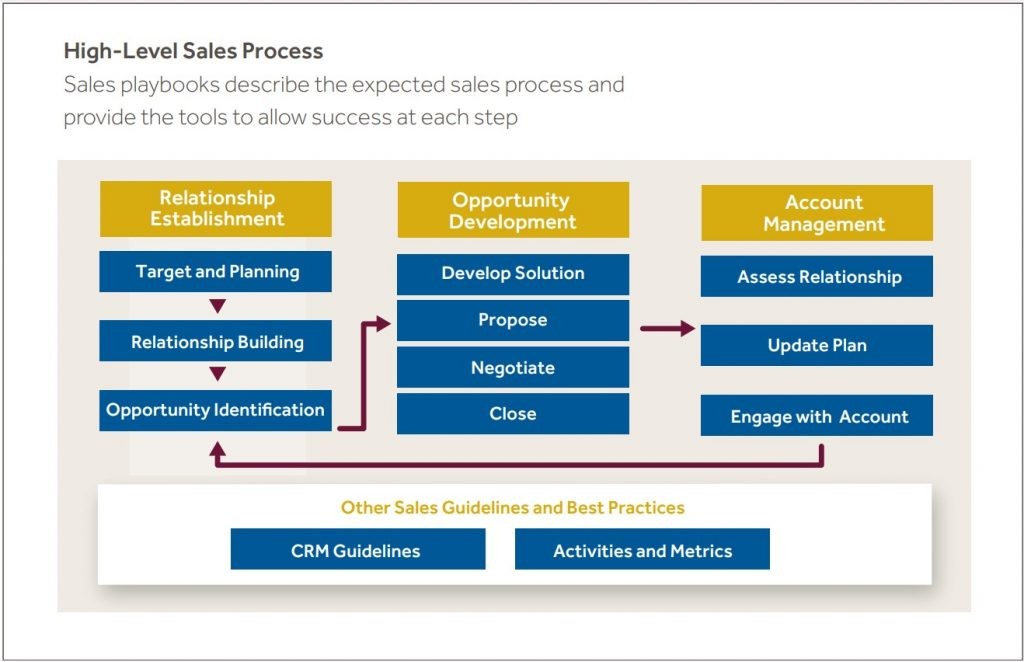
After detailing the sales process within those four categories, a helpful sales playbook provides the sales team with the following resources to help them apply the process successfully:
- A description of best practices at each step.
- A detailed list of methods corresponding to these best practices. These are the tips or “how-to’s” for applying the best practices.
- A list of resources that can be consulted, where applicable, for each step. These can be internal databases, lists of questions to ask the client, expected sections to include in an RFP response, etc.
- The suggested cadence for each step – how frequently should the sales rep be applying the described methods?
While the above items provide great detail on the individual steps and help the sales rep perform each step at a high level, the playbook should bring these pieces into an integrated whole. In general, we find everything boils down to two primary questions:
- What should I be doing? Provide sales reps with a sample calendar that, for a typical week, shows what percentage of their time should be spent actively selling, prospecting, attending sales meetings, and performing administrative tasks. Visually demonstrate these expectations by blocking out each activity in separate colors on a sample calendar. Set expectations for each activity (e.g. 3-4 selling appointments per week) as well as objectives (e.g., respond to all warm leads within 48 hours).
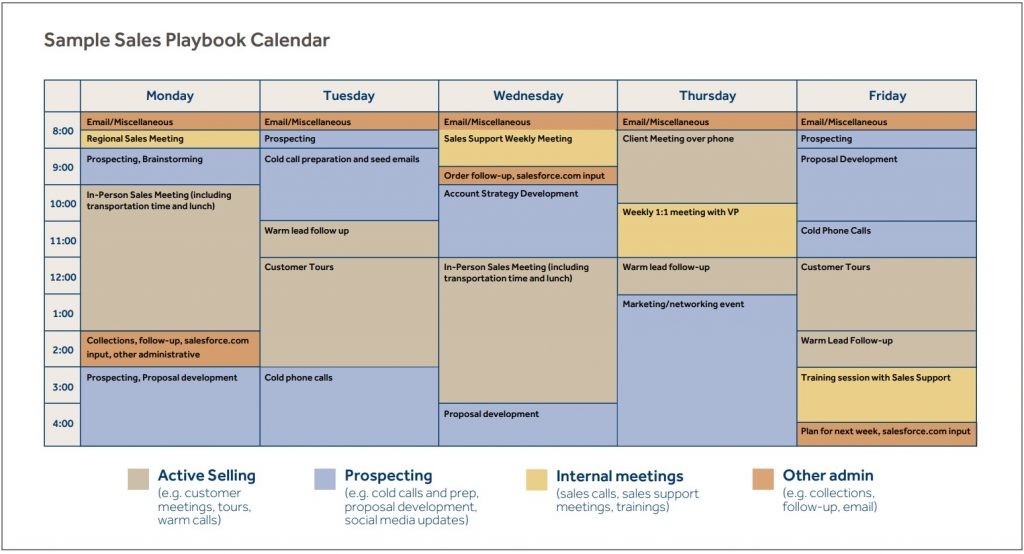
- How will I be measured? In addition to the stated commission plan, it’s important to establish the specific sales skills and associated management by objective goals (MBO) by which the sales reps will be judged. Any MBOs need to have specific and measurable metrics with an associated timeframe (e.g., attend six networking events each quarter; set 12 customer appointments each month). If expectations are clearly described as above, then it is relatively straightforward to translate those expectations into MBOs
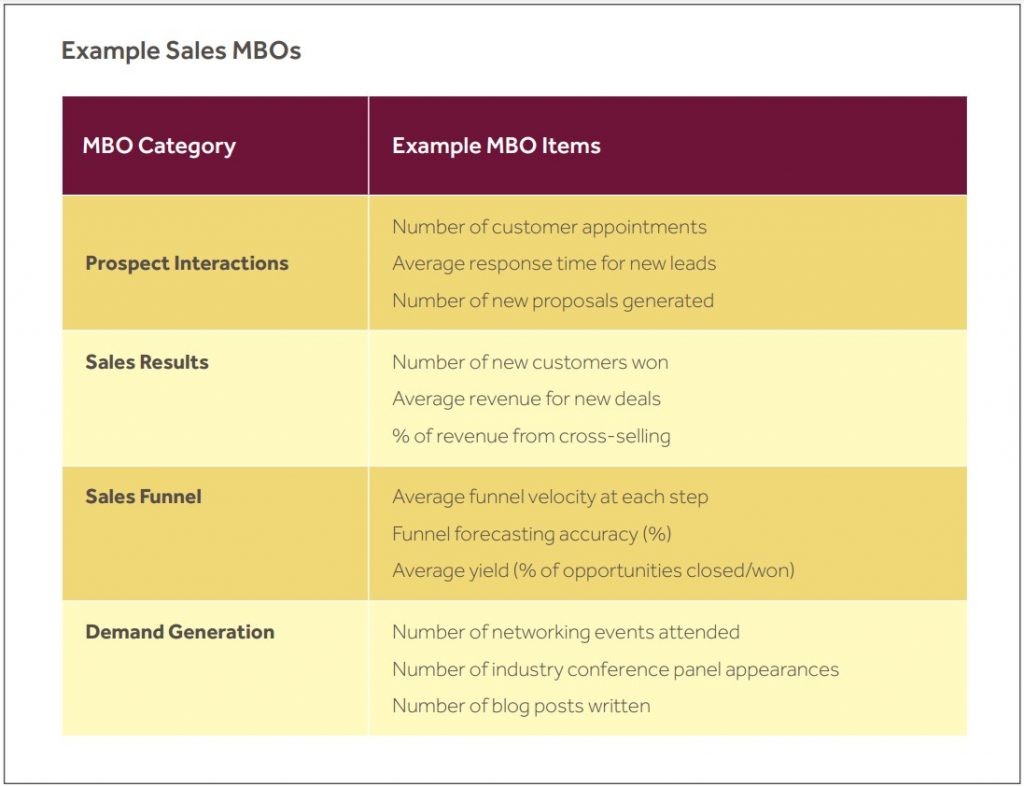
After learning and internalizing the sales playbook, a sales rep or account manager should know what they are expected to do, how they are expected to do it, how often, and where they can turn for additional help if needed.
Sales Management Playbook
Excelling in sales management demands a very different mentality than excelling in sales. As a result, we often find that sales managers struggle if they were promoted to their new roles based on their sales prowess instead of their management abilities. In order to be most helpful to sales managers, their playbook must address those items that are most relevant to managing high-performing sales teams.
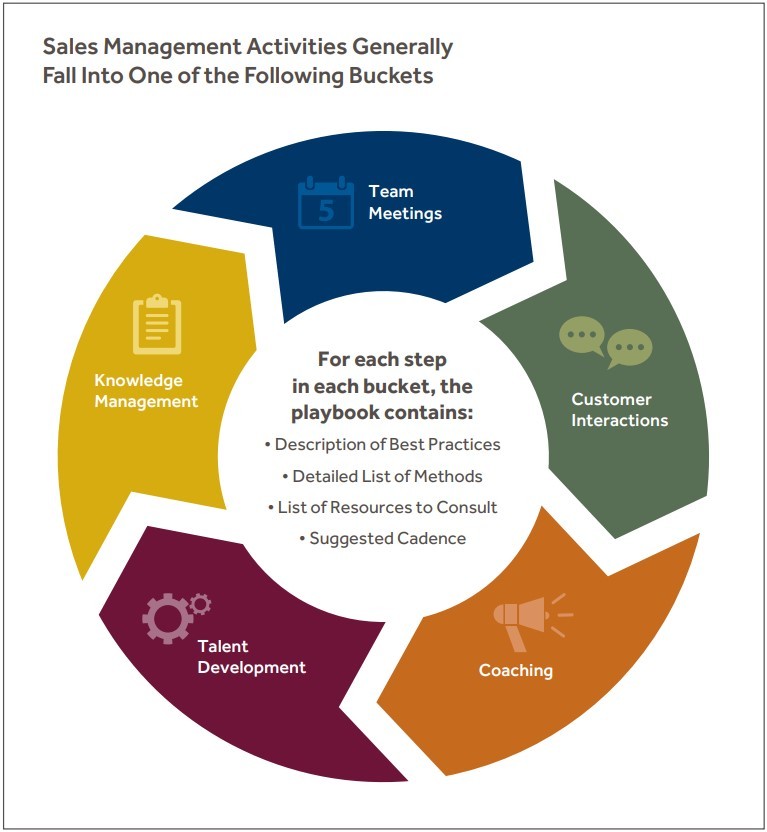
These management activities generally fall into one of the following buckets:
- Team meetings. Expectations for one-on-ones and team meetings, including content and frequency; striking a balance between reviewing numbers and using the meetings as group learning sessions.
- Customer interactions. Nature of participation and support provided in sales calls, ride-alongs, and requests for assistance (in particular for large or strategic accounts).
- Coaching. Coaching as the manager’s primary responsibility; expectations on how to coach, identifying coaching opportunities and touchpoints, ensuring sufficient time during team and one-on-one meetings for coaching.
- Talent development. Conducting skill assessments, creating development plans, and leveraging online and in-person training opportunities.
- Knowledge management. Expectations for keeping abreast of industry and company developments and proactively sharing knowledge with the sales team.
- Activity measurement. Reviewing activity levels, addressing activity shortfalls, and ensuring data accuracy in sales systems/CRM.
For each of the steps outlined in the above topics, the resources provided in the sales manager playbook should be similar to those in the sales rep playbook:
- description of best practices for each activity
- A detailed list of methods for each best practice
- A list of resources that can be consulted for each step
- The suggested cadence for each step
As with the sales playbook, establishing expected activities and cadences is an important part of the sales manager’s playbook. The form this takes for sales managers varies, however, as it is important that managers don’t lose sight of the big picture while immersing themselves in the detail. We find that a simple grid with the following components can be highly effective:
- For each manager role (e.g. VP, territory manager), create a row on the grid
- Columns correspond to timeframe: daily, weekly, monthly, quarterly, yearly, etc.
- In each cell, include a separate bullet for the activities that should be completed in that timeframe (e.g., “conduct one-on-ones with sales reps” goes into the “weekly” box for a territory manager, while “focus on talent development” is a quarterly or semi-annual activity for a sales VP)
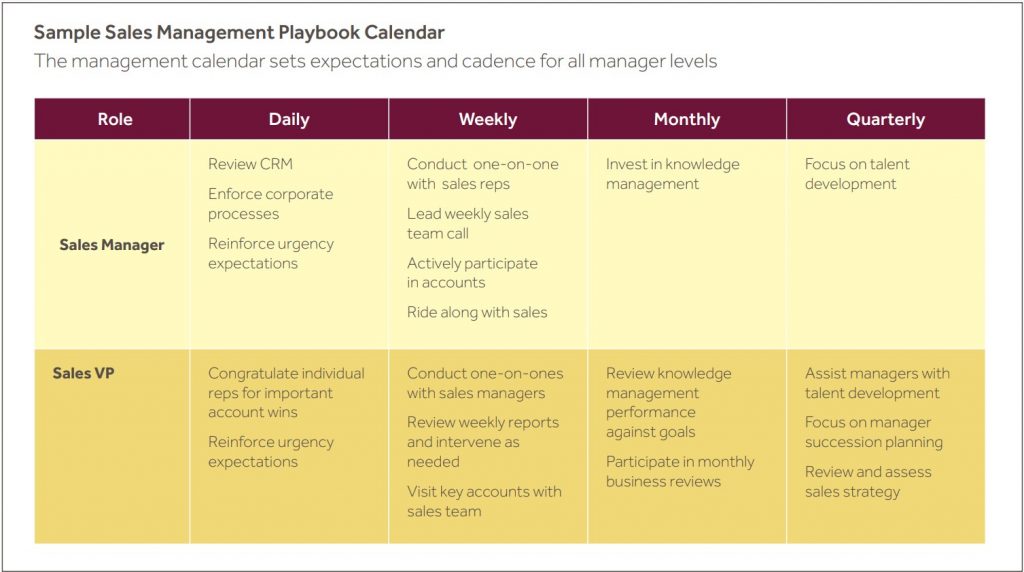
This structure allows all sales managers, at all levels, to clearly understand their expectations and cadence, which in turn helps them be effective managers who can enable high-performing sales teams.
Creating the Sales Playbook
A company-directed sales organization puts in a significant effort to develop and disseminate its playbook. Playbooks are company specific. They are driven by customer needs, buyer values, buyer behaviors, and company culture so one size does not fit all. To develop customized sales playbooks, sales leaders should do the following:

- Create a framework for the sales process. Though the specific details of the sales process will be amended after speaking with the sales team, it is helpful to have a straw man as a starting point for discussions. Rather than asking reps to describe what they do, guiding them to describe how they establish relationships, identify opportunities, negotiate, etc. will lead to richer descriptions of best practices. See the Sales Playbook section above for a more detailed description of sales process components.
- Interview high- and low-performing sales reps. While interviewing high performers is an obvious step, oftentimes companies do not think about interviewing low
performers. Not only do the low performers serve to highlight contrasts in technique, they also can be a source of good individual practices, even if on the whole their approach isn’t successful. If the sales team has different roles (e.g. hunters/farmers, direct sales/partner management), be sure to include all selling teams. - Interview high- and low-performing sales managers. Good sales management can help an average sales team exceed expectations. Poor sales management can bring down an otherwise high-performing team. Interviewing managers helps address the impact the managers might have on outcomes. In addition, experienced managers can provide more insight than individual reps, who may not have the self-awareness to understand why they are successful.
- Go beyond “what?” and “how?” questions. Investigate “why?” to understand the rationale behind actions taken and resources consulted. Ask “when?” to get a sense for the cadence and frequency of activities performed. Learn “whom” they consult for assistance throughout the process and “where” they turn for facts, data, and other resources.
Rolling Out the Sales Playbook
As with any transformative sales effort, adopting a sales playbook hinges on successful change management. In our experience, mastering the science of making change happen accounts for 70% of the value created in a transformative sales effort; developing the playbook itself only delivers 30%. We have found there are ten useful techniques for implementing sales playbooks:
- Obtain design input from those impacted – sales and sales management representatives need to be involved in the design.
- Avoid the Big Bang – use pilots and phased rollouts where possible.
- Describe the vision/purpose – articulate the end state and its benefits over the status quo.
- Share details of the new playbook, not just a high-level description.
- Introduce a single leader – one person is in charge and accountable.
- Explain how the organization is going to transition to using the playbook.
- Provide the right tools, including the playbook and any associated templates and software.
- Explain new metrics for activities and outputs – and capture them within the playbook itself.
- Ensure visible sponsorship from the leadership team.
- Iterate – recognize that the first version is not final and that the playbook should be evergreen.
One client experience provides a good example of these 10 techniques in action:
- The CEO recognized the need for a company-directed sales organization and became the chief proponent of the change effort. Although he put the head of sales operations in charge of the effort, he convened a special sales team meeting to explain the need for a playbook as well as the vision for the end state. (Techniques 3, 5, 9)
- The head of sales operations convened a sales playbook team and a sales management playbook team. Representatives included not only sales but also other functions that would be impacted by the sales process, including IT, marketing, finance, and HR. (Technique 1)
- The head of sales operations and sales leadership introduced the playbooks at the annual sales team meeting, where they reiterated the vision, described the playbook and explained the transition plan. (Techniques 3, 4, 6)
- After the annual sales meeting, Blue Ridge Partners (BRP) trained the sales managers on the details of the sales playbook so managers could speak to the details when questions came up within their teams. BRP additionally trained each sales team on the sales playbook and associated supporting tools, and individually trained each sales manager on the sales manager playbook. These training sessions involved walking through each section of the playbooks to describe them in detail. (Techniques 4, 6, 7)
- Sales operations put new metrics in place for the sales team and these were discussed in the sales meeting, the individual training session, and reinforced as MBOs in compensation plans. (Technique 8)
- The team designed the playbooks from the beginning to be evergreen, with a quarterly review process and a new version released each year. (Technique 10)
- In this case, the client chose not to pilot or implement a phased rollout, but because there was a 3- to 4-month period between the playbook’s introduction and its rollout, they avoided a Big Bang. (Technique 2)
After rolling out the playbook, this client found its sales team began speaking a new, common language that enabled it to think about the sales process in a more strategic and structured way. While not every rep is an active user, new reps have found it to be very helpful to set their direction and expectations during the onboarding process. For a company that turned over most of a sales division over the course of a few months in order to increase its sales talent, having a standard playbook to manage this influx of new sales personnel has proven invaluable. Its sales training function has since taken over ownership of the playbook and reviews it every six months to keep it up to date as the market changes.
Holding Sales Teams Accountable
One of the second-order benefits to a sales playbook is that it provides a structured way for sales managers to coach their sales teams and for sales leaders to hold sales managers accountable for their team’s performance. While accountability is key to any successful sales team, it is especially important in businesses with long sales cycles, where significant time elapses between activities and results.
Effective sales playbooks and sales manager playbooks create a framework for more effective coaching and accountability in a number of ways:
- Sales expectations are defined. From targeting to messaging to closing to account management, the sales playbook describes each step in the sales process, details the actions successful reps need to take, and moves beyond the “what” and the “how” to answer “why,” “where,” and “when” questions. The recipe is written down for reps to follow and improve, and for managers to coach against and enforce.
- Management expectations are defined. Similarly, the manager playbook establishes the recipe for a manager of a high-performing sales team. In this case, the activities are not geared toward selling, rather they are about empowering sales reps to sell. Conducting effective meetings, providing the appropriate support in the field, relying on both carrot (coaching) and stick (enforcement) to drive results – these methods are defined in the playbook and communicated during roll-out. A sales leader can hold managers accountable to specific management expectations.
- Metrics are clarified. In addition to the usual sales, growth, and customer metrics, a thorough playbook sets expectations for activities, including the number of touches, number of new prospects contacted, number of proposals, number of decision-maker meetings, and so on. This helps managers intervene before it is too late, particularly for longer sales cycles. While calling a sales team “coin-operated” is overly simplistic and one sign that the wrong talent and motivations are in place, sales do respond strongly to incentives, both monetary and non-monetary. Setting MBOs, contests, and recognition programs around activities helps reinforce desired behavior.
- The cadence is established. The sales manager playbook describes the number, type, and frequency of coaching and accountability sessions. As mentioned previously, setting up a cadence of activities and responsibilities by level (e.g. Director vs. VP) and timeframe (daily, weekly, monthly, quarterly, etc.) helps ensure the right coaching interventions occur at the right time for them to have an impact.
Conclusion
Institutionalizing, implementing, and holding leaders accountable for a sales playbook and a sales management playbook allows a company to move from a self-directed sales organization to a company-directed sales organization. Moving to a company-directed model helps propagate best practices and consistency in their application, ultimately driving higher performance from the sales team. If something does go wrong, root causes are easier to diagnose as everyone is following the same process.
A company-directed sales organization cannot be willed into existence, however. Any organization intending a transformation from a self-directed unit needs to master the science of making change happen, utilizing the ten techniques we have found to be successful for this purpose.
While the investment of time, management attention, and communication efforts are significant, so are the rewards that result from a consistently high-performing sales team and the reduced risks of missed targets and spotty forecasting.


